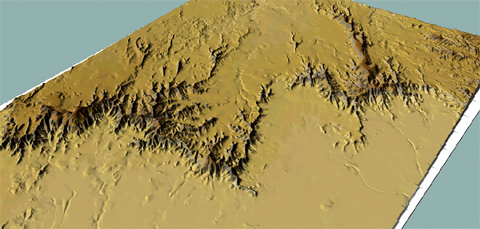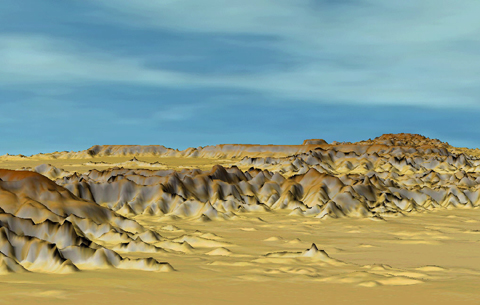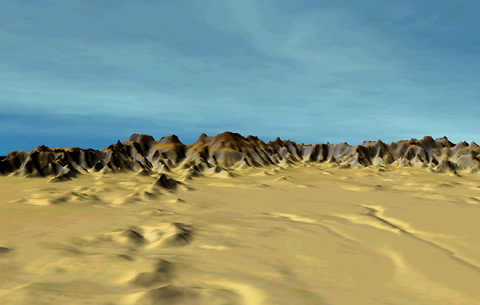Across the high plains of the United States, sedimentary strata ranging in
age from Cretaceous to Tertiary were deposited in a shallow epicontinental
seaway in extensive horizontal layers. These strata are generally composed
of fine sandstone, siltstone, shale, and volcanic ash and are very easily eroded.
 <a onClick="window.open('/olcweb/cgi/pluginpop.cgi?it=jpg::::/sites/dl/free/0077373731/30425/VirtualVista0501.jpg','popWin', 'width=NaN,height=NaN,resizable,scrollbars');" href="#"><img valign="absmiddle" height="16" width="16" border="0" src="/olcweb/styles/shared/linkicons/image.gif"> (131.0K)</a>
<a onClick="window.open('/olcweb/cgi/pluginpop.cgi?it=jpg::::/sites/dl/free/0077373731/30425/VirtualVista0501.jpg','popWin', 'width=NaN,height=NaN,resizable,scrollbars');" href="#"><img valign="absmiddle" height="16" width="16" border="0" src="/olcweb/styles/shared/linkicons/image.gif"> (131.0K)</a>
Stream incision into these loosely consolidated deposits combined with effects
of weathering and erosion resulted in formation of "badlands" -
a highly irregular landform composed of complex gullies with little or no
soil or vegetation.
 <a onClick="window.open('/olcweb/cgi/pluginpop.cgi?it=jpg::::/sites/dl/free/0077373731/30425/VirtualVista0503.jpg','popWin', 'width=NaN,height=NaN,resizable,scrollbars');" href="#"><img valign="absmiddle" height="16" width="16" border="0" src="/olcweb/styles/shared/linkicons/image.gif"> (130.0K)</a>
<a onClick="window.open('/olcweb/cgi/pluginpop.cgi?it=jpg::::/sites/dl/free/0077373731/30425/VirtualVista0503.jpg','popWin', 'width=NaN,height=NaN,resizable,scrollbars');" href="#"><img valign="absmiddle" height="16" width="16" border="0" src="/olcweb/styles/shared/linkicons/image.gif"> (130.0K)</a>
At Badlands National Park in South Dakota, USA, this landform is very well
developed in sedimentary strata from the Tertiary Period, as these Virtual Vistas illustrate. The exposed bluffs of semi-consolidated
sedimentary materials are continually changing as wind and water sculpt the
land surface.
Erosion is so efficient, no soil forms on the exposed slopes, and vegetation
cannot gain a foothold in the crumbling debris. The lack of vegetation enhances
the efficiency of wind and water erosion in this landscape.
 <a onClick="window.open('/olcweb/cgi/pluginpop.cgi?it=jpg::::/sites/dl/free/0077373731/30425/VirtualVista0504.jpg','popWin', 'width=NaN,height=NaN,resizable,scrollbars');" href="#"><img valign="absmiddle" height="16" width="16" border="0" src="/olcweb/styles/shared/linkicons/image.gif"> (107.0K)</a>
<a onClick="window.open('/olcweb/cgi/pluginpop.cgi?it=jpg::::/sites/dl/free/0077373731/30425/VirtualVista0504.jpg','popWin', 'width=NaN,height=NaN,resizable,scrollbars');" href="#"><img valign="absmiddle" height="16" width="16" border="0" src="/olcweb/styles/shared/linkicons/image.gif"> (107.0K)</a>
To learn more about Badlands National Park, visit the National
Park Service website.
Take a virtual flight over the unearthly terrain of South Dakota' badlands by clicking on the video link below.
1. Visit the National Park Service web site to determine what types of fossils have been found in badlands deposits.
2. What factors may contribute to the occurrence of badlands? Are there other badlands in the United States? Are there other badlands elsewhere in the world?
3. Are these features formed by ongoing, active processes or are they ancient features of the landscape?
4. What observations might be used to determine how old these features are?



